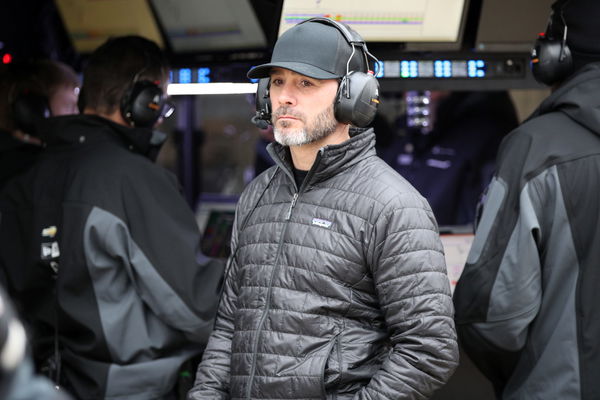
via Getty
AUSTIN, TEXAS – FEBRUARY 11: NASCAR driver Jimmie Johnson attends NTT IndyCar Series testing at Circuit of The Americas on February 11, 2020 in Austin, Texas. (Photo by Chris Graythen/Getty Images)

via Getty
AUSTIN, TEXAS – FEBRUARY 11: NASCAR driver Jimmie Johnson attends NTT IndyCar Series testing at Circuit of The Americas on February 11, 2020 in Austin, Texas. (Photo by Chris Graythen/Getty Images)
Is the charter system a good avenue for the teams to generate income and stay afloat in the challenging motorsports market? Well, given the ongoing struggles between NASCAR and Michael Jordan, it’s tough to predict the future of the charter system. However, with the current deal, along with the $7.7 billion media rights agreement, the sport is headed in the right direction.
Legacy Motor Club co-owner who has brought in private investment to his team, feels that the charter system is indeed a good model. The seven-time champ understands the difference of the unique financial equation compared to other stick and ball sports. Despite the new deal and better revenue splits, Johnson feels that he is playing catch-up to the legacy teams. He aired out his complaints against the traditional system while speaking on the Business of Sport podcast.
ADVERTISEMENT
Article continues below this ad
The Power Struggle Between Legacy and Innovation in NASCAR
“We are not a league like the NFL or NBA. We’re private contractors, and charters give us some of that structure that other leagues have. The goal is to create long-term value and a competitive product on the track,” Johnson explained. Although NASCAR has tried to create value for the teams through charters, the sport itself is controlled by the France Family, it is a private entity, unlike the NBA or NFL.
He believes that NASCAR will become more financially stable through charters, bringing it into line with other major sports. A significant change from the previous paradigm, in which teams had to qualify for every race without any financial guarantees, was brought about with NASCAR’s introduction of charters in 2016. Only four vacant spots remained after the new mechanism locked in 36 spots every week. It was intended to increase the stability and investment appeal of team ownership. But there’s a catch: The charter system isn’t entirely fair for newcomers and small teams operating in the Cup Series.
“You have to buy the charter. There are some leasing opportunities where you can lease a charter for a year, but ultimately the goal is for ownership and to support the teams that commit to the sport, and the demand is what’s gonna create the increase in enterprise value. And for some of them who started for the teams that were with NASCAR from the beginning, they were gifted the charters. I think our new high watermark is at 40$ million a charter. We had three charters transacted at 40$ million and a few more cents, but there were fewer assets attached. Now that we have our new charter agreement. I think you are gonna see 45, 50, 55, the charters are gonna continue to rise.” Johnson added further.
With recent revenue hitting $40 million and estimates rising to $50–$55 million, NASCAR charters have seen a sharp increase in value. Interestingly, now that Johnson is the co-owner of the team, he understands that the legacy teams are going to have an upper hand over the newcomers. Especially when he and his partners had to invest while teams like JGR, HMS and Penske were handed not just one but our charters.
He added, “I think if NASCAR could start now with a clean sheet of paper, it could be less confusing, but you have all these grandfather issues that continue to trickle on.” Well, unlike the three grandfather teams, LMC can’t expand to four car operations, and certainly, these owners will have a better return on their exit. These teams didn’t have to shell out the big dollars to get hold of the charters yet they will profit from their sale. Not to forget, four against three there’s still a numerical disadvantage these teams will face on the racetrack.

USA Today via Reuters
NASCAR, Motorsport, USA Sprint Unlimited-Practice, Feb 12, 2016 Daytona Beach, FL, USA NASCAR Sprint Cup Series driver Jimmie Johnson 48 talks with NASCAR Sprint Cup Series driver Denny Hamlin 11 during practice for the Sprint Unlimited at Daytona International Speedway. Mandatory Credit: Peter Casey-USA TODAY Sports, 12.02.2016 17:01:18, 9110691, Jimmie Johnson, Daytona International Speedway, NASCAR, NASCAR Sprint Cup Series, Sprint Unlimited, Denny Hamlin PUBLICATIONxINxGERxSUIxAUTxONLY Copyright: xPeterxCaseyx 9110691
What’s your perspective on:
Is NASCAR's charter system a fair game, or just a legacy team's playground?
Have an interesting take?
He points out that there are competitive disparities because new clubs are only allowed to have three charters, whereas legacy teams are allowed to keep four unless ownership changes. Given that NASCAR’s value has increased, particularly over the past five years, Johnson views the sport’s growing franchise valuations as a significant investment opportunity. In order to secure long-term viability and draw in new investors, he plans to broaden NASCAR’s financial and commercial reach by taking advantage of the rising value of live sports.
This disparity can be seen on the racetrack as well. Although LMC is a tier-1 Toyota partner, they are nowhere near the likes of 23XI Racing and Trackhouse Racing. It has to be noted that 23XI Racing has a technical alliance with JGR, and they have to shell out extra money to use the resources from the big brother Toyota team. So you see, the path to success goes through the legacy teams and for the time being, they are the ones calling the shots.
Despite their own program with Toyota, LMC’s problems persist. But it will be interesting to see how they will grow over the years and if they will be able to match the level of big brother teams. As far as charters go, there’s no clear roadmap on whether NASCAR will stick with this process as they are facing an anti-trust lawsuit over charter disagreements with 23XI Racing and FRM.
Trending
NASCAR’s Charter Battle: Financial Survival vs. Tradition
NASCAR teams have been dependent on sponsorships for years, with broadcast rights and prize money offering little assistance. Many owners, including Jimmie Johnson, believe that the charter system is crucial for maintaining financial stability as costs rise. “It costs us $18 million to put a car on the racetrack,” said Denny Hamlin.
ADVERTISEMENT
Article continues below this ad
Hamlin has brought attention to the problem by stating that teams only earn 35–39% of NASCAR’s total revenue, which is significantly less than other major sports organizations, but it costs $18 million a year to field a competitive car. Only seven of the original 19 teams have remained after charters were introduced in 2016, highlighting the necessity of financial stability.
Although the new charter deal bumped up the TV revenue to 28%, Michael Jordan and Bob Jenkins weren’t sold on the new proposal. These negotiations stalled for over 2 years, and finally, NASCAR put down the hammer with a take it or leave it proposition ahead of playoffs last year. The two teams defied NASCAR’s orders and have taken them to court. They did win the first battle after securing an injunction, but the sanction body has finally made a stern response to the accusation of being a monopolistic bully.
The charter system disagreement is intensified by NASCAR’s countersuit against 23XI Racing, Front Row Motorsports, and co-owner Curtis Polk. While the teams contend that NASCAR has monopolistic power, NASCAR asserts the teams attempted to “coerce and extort” better financial terms. The case began when 23XI and Front Row refused to sign new charter agreements despite NASCAR’s media rights contract boosting team revenue shares to nearly 50%. NASCAR is challenging a court’s decision to grant both teams an injunction to race in 2025, even threatening to do away with charters if it is forced to renegotiate.
ADVERTISEMENT
Article continues below this ad
With a trial scheduled for December 2025, the case may change revenue and team ownership structures. Brad Keselowski cautions of serious repercussions since a decision against NASCAR would give teams more financial authority, affecting sponsorships, investments, and manufacturer participation.
ADVERTISEMENT
ADVERTISEMENT
ADVERTISEMENT
ADVERTISEMENT







Is NASCAR's charter system a fair game, or just a legacy team's playground?